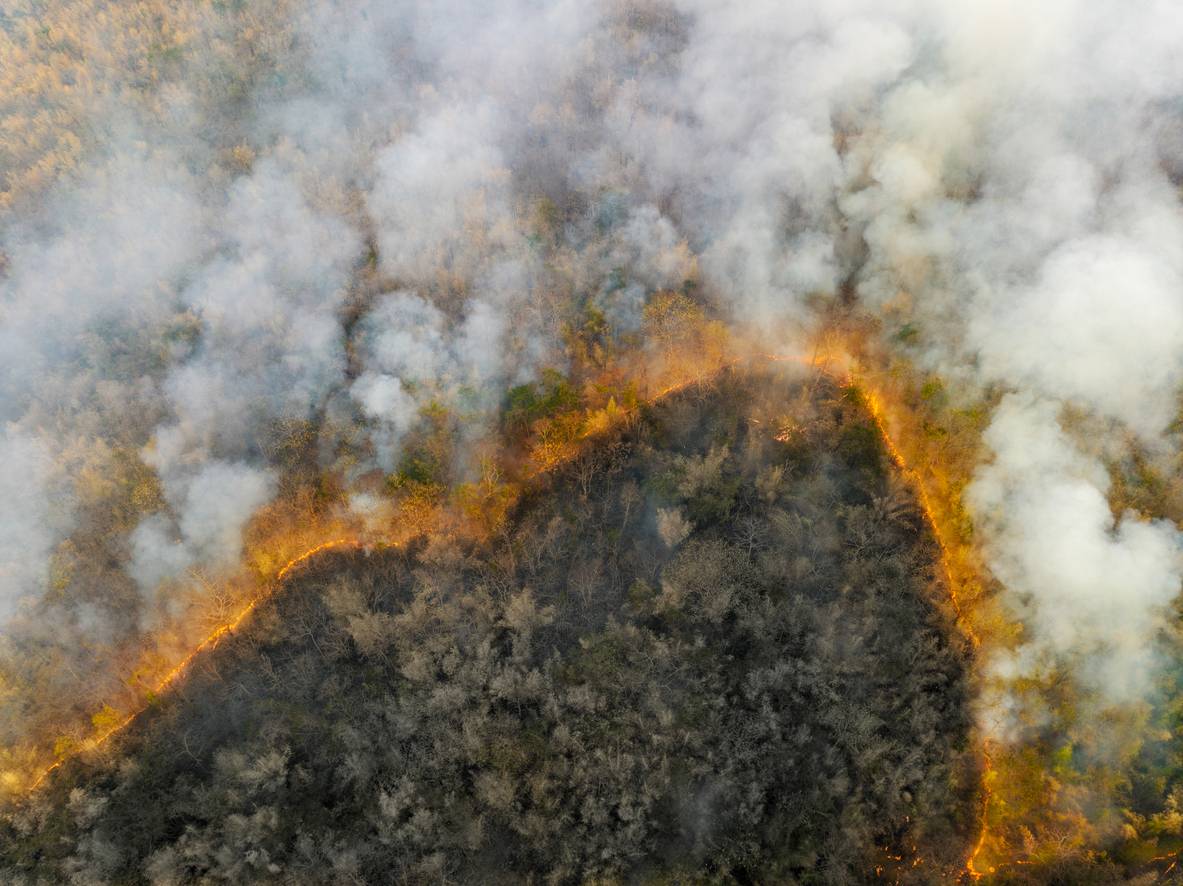
Although wildfires have occurred naturally for thousands of years, the intensity and frequency of these catastrophic events have increased in recent years due to climate change and human activities (1). In 2021 alone, over 60,000 wildfires burned more than 7 million acres, representing a 223% increase since 1983 (2). Additionally, human activities cause more than 85% of wildfires, resulting in billions of dollars of damage every year in the United States (2). These catastrophic natural disasters damage property and wildlife, but wildfire also pose significant short-term and long-term threats to human health.
Immediate health consequences from wildfires stem from the exposure to flames and smoke. First, although wildfires are typically less fatal than home fires, exposure to wildfire flames can cause burns, injuries, and suffocation, which resulted in the deaths of 2,400 Americans between 1998 and 2017 (3). More often, however, the short-term health outcomes from wildfires arise from the exposure to smoke, which affects millions of Americans every year (4). Wildfire smoke contains a dangerous combination of carbon dioxide, carbon monoxide, hazardous air pollutants (HAP), and, crucially, particulate matter that is released into the air during the burning of vegetation (5). Wildfires produce a lot of small particulate matter, such as PM2.5, which is particles composed of various chemical compounds that measure less than 2.5 micrometers in diameter, that is particularly harmful (6). The microscopic size of the particles allows them to travel through air and become trapped deep in human lungs (6). Thus, exposure to particle pollution from wildfire smoke can cause the immediate manifestation of respiratory symptoms, including coughing, respiratory tract irritation, difficulty breathing, asthma exacerbations, reduced lung function, and bronchitis (6).
Acute respiratory symptoms can persist for days following exposure and can spiral into serious conditions (6). The severity and longevity of health outcomes depends on the length of exposure to wildfire smoke and the vulnerability of the affected individuals (7). Children, elderly adults, and individuals with chronic conditions are most likely to suffer severe symptoms, hospitalizations, and, in some cases, death (7). Following the onset of acute respiratory symptoms, the damage to the inflammatory and respiratory systems caused by particle pollution can lead to serious conditions, including heart attack, heart failure, and stroke, especially in individuals with developing lungs, respiratory conditions, or cardiovascular disease (6). Additionally, conditions such as chronic obstructive pulmonary disease (COPD) and asthma can be exacerbated, leading to long-term lung damage and increased risk of respiratory infections (6).
Years after the smoke has cleared and the flames have been extinguished, many wildfire survivors suffer from long-term health consequences (6). Although researchers have traditionally focused on the acute effects of wildfire exposure, some studies have documented chronic symptoms, especially in firefighters and residents of areas prone to wildfires. Two studies of wildfire survivors showed an increase in chronic bronchitis in both children and adults (8, 9); additionally, one study showed an increased risk of heart attack (9). Increased risk of cancer may also arise from wildfire exposure, though some studies have not found significant associations (10). Additionally, mental health conditions appear to plague survivors, with self-reported symptoms of post-traumatic stress disorder (PTSD), depression, and anxiety worsening in survivors compared to their pre-wildfire baseline (11). While the long-term effects of wildfires must be further investigated, research shows significant impacts to every aspect of human health.
In the future, wildfires are expected to increase in severity and lethality due to climate change and human activities (1). The number of individuals exposed to PM2.5 in wildfire smoke is expected to rise, resulting in more cases of acute respiratory distress and, potentially, long-term consequences from particle pollution (4). Vulnerable individuals and residents of areas prone to wildfires remain at the highest risk for severe health consequences, though anyone exposed to wildfire flames and smoke can suffer both short-term and long-term outcomes. Despite this dire outlook, wildfires and their consequences may be decreased by cutting greenhouse gas emissions, improving wildfire management, and educating the public on safe practices and wildfire prevention (6).
References
1: United States Environmental Protection Agency. 2022. Climate change indicators: wildfires. EPA. URL: https://www.epa.gov/climate-indicators/climate-change-indicators-wildfires#:~:text=The%20extent%20of%20area%20burned,have%20increased%20since%20the%201980s.
2: Martin, S. 2023. 2023 US wildfire statistics. Bankrate. URL: https://www.bankrate.com/insurance/homeowners-insurance/wildfire-statistics/.
3: World Health Organization. 2023. Wildfires. WHO. URL: https://www.who.int/health-topics/wildfires#tab=tab_1.
4: Milman, O. 2023. ‘Dramatic’ rise in wildfire smoke triggers decline in US air quality for millions. The Guardian. URL: https://www.theguardian.com/environment/2022/sep/22/air-quality-wildfire-smoke-pollution-health-risks.
5: Reid, C., Brauer, M., Johnston, F., Jerrett, M., Balmes, J., and Elliott, C. 2016. Critical review of health impacts of wildfire smoke exposure. Environmental Health Perspectives, vol. 124. DOI: 10.1289/ehp.1409277.
6: Grant, E. and Runkle, J. 2022. Long-term health effects of wildfire exposure: a scoping review. The Journal of Climate Change and Health, vol. 6. DOI: 10.1016/j.2021.100110.
7: United States Environmental Protection Agency. 2022. Which populations experience greater risks of adverse health effects resulting from wildfire smoke exposure? EPA. URL: https://www.epa.gov/wildfire-smoke-course/which-populations-experience-greater-risks-adverse-health-effects-resulting.
8: Matz, C., Egyed, M., Xi, G., Racine, J., Pavlovic, R., Rittmaster, R., Henderson, S., and Stieb, D. 2020. Health impact of PM2.5 from wildfire smoke in Canada. Science of the Total Environment, vol. 725. DOI: 10.1016/j.scitotenv.2020.138506.
9: Neumann, J., Amend, M., Anenberg, S., Kinney, P., Sarofim, M., Martinich, J., Lukens, J., Xu, J., and Roman, H. 2021. Estimating the PM2.5-related premature mortality and morbidity associated with future wildfire emissions in the western US. Environmental Research Letters, vol. 16. DOI: 10.1088/1748-9326/abe82b.
10: O’Dell, K., Hornbrook, R., Permar, W., Levin, E., Garofalo, L., Apel, E., Blake, N., Jarnot, A., Pothier, M., Farmer, D., Hu, L., Campos, T., Ford, B., Pierce, J., and Fischer, E. 2020. Hazardous air pollutants in fresh and aged western US wildfire smoke and implications for long-term exposure. Environmental Science and Technology, vol. 54. DOI: 10.1021/acs.est.0c04497.
11: Agyapong, V., Ritchie, A., Brown, M., Noble, S., Mankowski, M., Denga, E., Nwaka, B., Akinjise, I., Corbett, S., Moosavi, S., Chue, P., Silverstone, P., and Greensha, A. 2020. Long-term mental health effects of a devastating wildfire are amplified by sociodemographic and clinical antecedents in elementary and high school staff. Frontiers in Psychiatry, vol. 11. DOI: 10.3389/fpsyt.2020.00448.

